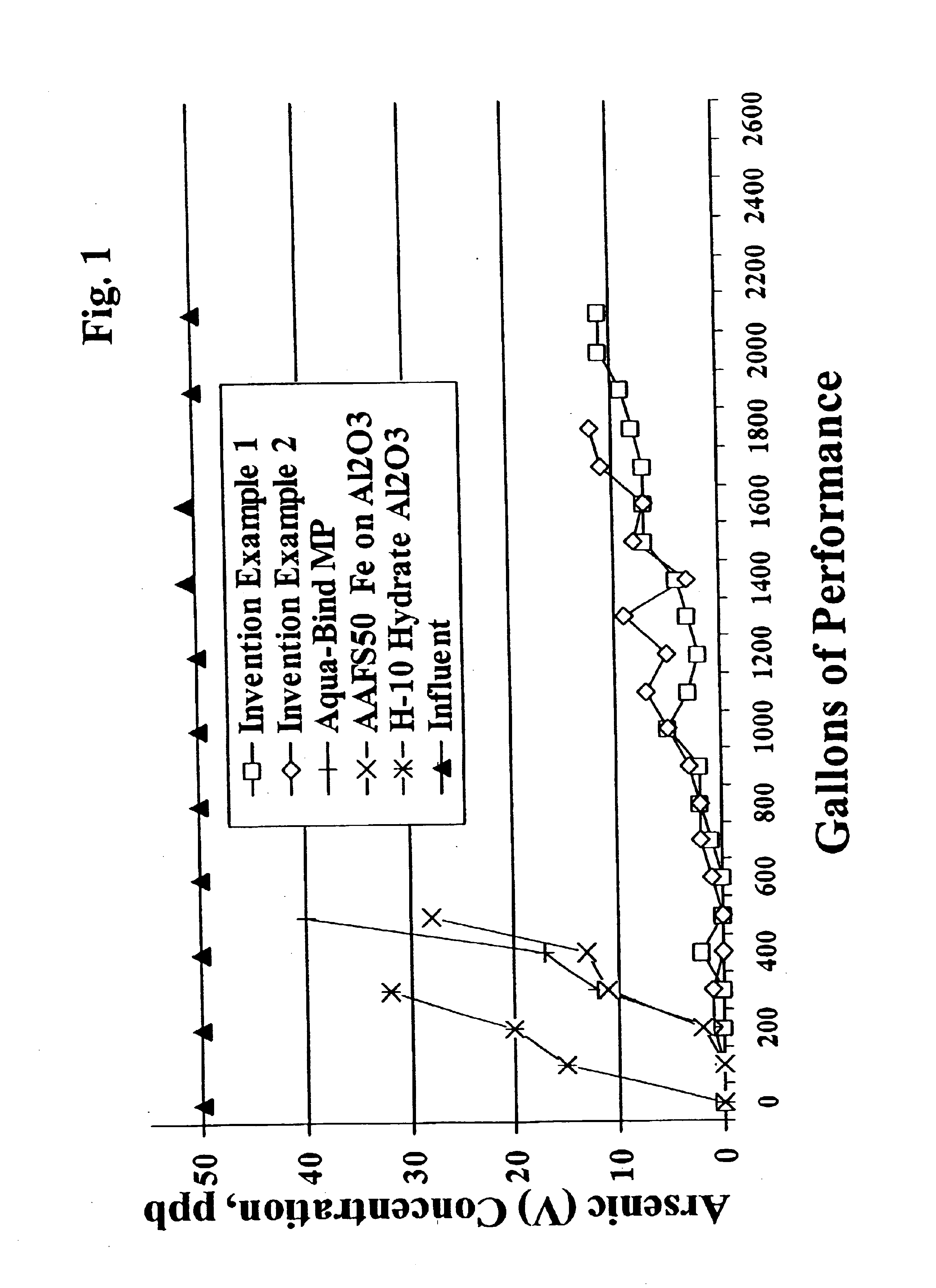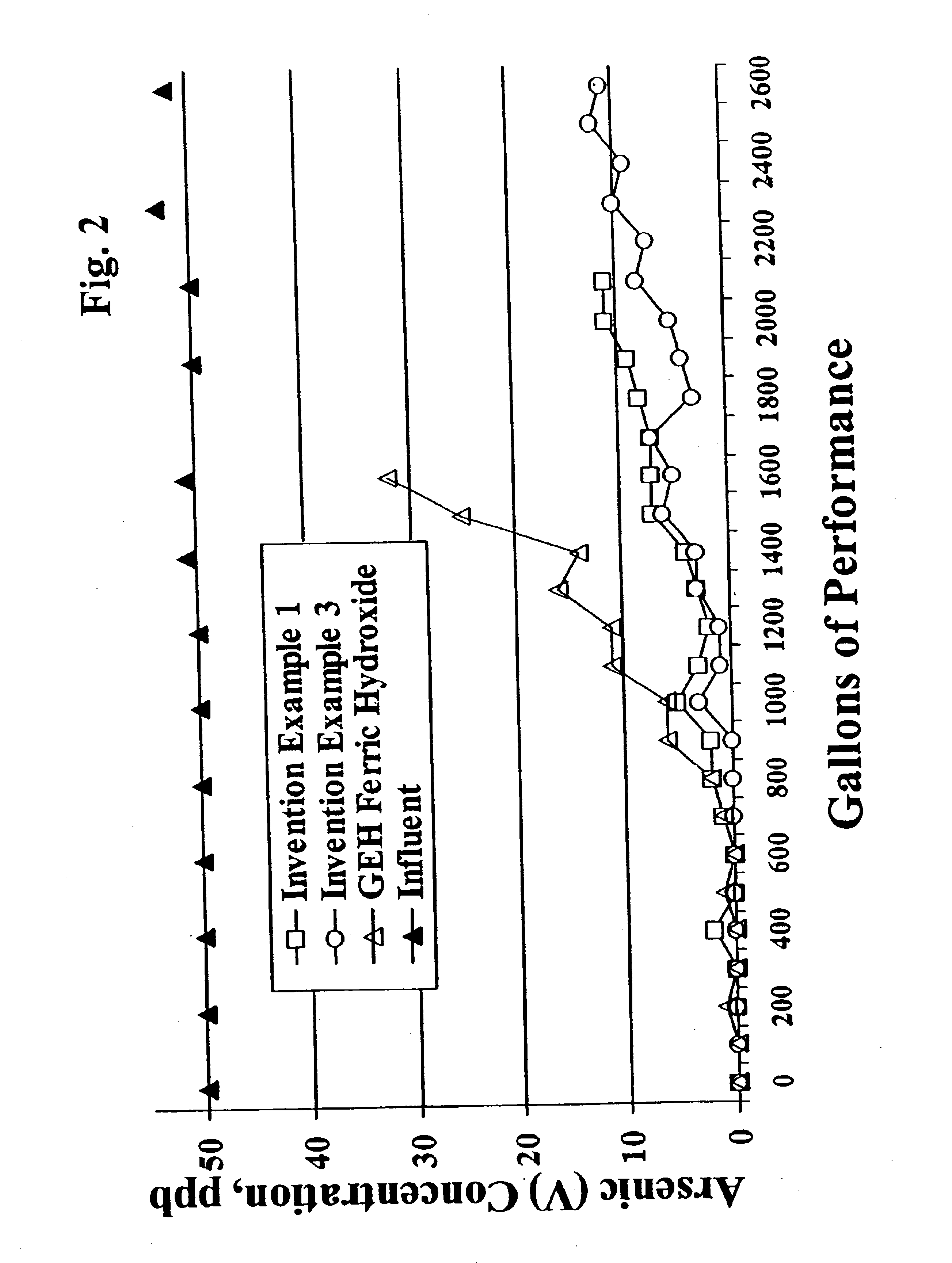Arsenic removal media
- Summary
- Abstract
- Description
- Claims
- Application Information
AI Technical Summary
Benefits of technology
Problems solved by technology
Method used
Image
Examples
example 1
[0052]15 lbs of water is added to a 35 gallon holding tank equipped with a mixer. 71 lbs of 40% ferric chloride solution is loaded into a separate 15 gallon tank. 15 lbs of water and 40 lbs of 50% sodium hydroxide are loaded into another separate 15 gallon tank. The ferric chloride solution and the diluted sodium hydroxide solutions are pumped simultaneously into the 35 gallon holding tank while mixing. The pH of the resultant slurry is maintained from 6.6 to 7.2 throughout the entire precipitation reaction. After all of the solutions are pumped into the reactor tank, the pH is adjusted to 7.0. The reactor slurry is pumped into a plate and frame filter press and then washed with 1100 gallons of water until the exit water has a conductivity of 80 micromhoes greater than the incoming water. The filter cake is unloaded from the press and allowed to dry at room temperature (about 25° C.) in plastic trays. The dried filter cake is then milled in a Como-Mill and hand screened −30 and +60 ...
example 2
[0053]40 lbs of water is added to a 35 gallon holding tank equipped with a mixer. 75 lbs of water and 71 lbs of 40% ferric chloride are loaded into a separate 15 gallon tank. 95 lbs of water and 40 lbs of 50% sodium hydroxide are loaded into another separate 15 gallon tank. The diluted ferric chloride solution and the diluted sodium hydroxide solutions are pumped simultaneously into the 35 gallon holding tank while mixing. The pH of the resultant slurry is maintained from 6.5 to 8.0 during the precipitation reaction. After all of the solutions are pumped into the reactor tank, the pH is adjusted to 7.1. The reactor slurry is pumped into a plate and frame filter press and then washed with 2500 gallons of water until the exit water has a conductivity of 600 micromhoes greater than the incoming water. The filter cake is unloaded from the press and dried @ 80C. for 24 hours. The dried filter cake is then milled in a Como-Mill and hand screened −30 and +80 to produce 30×80 mesh ferric hy...
example 3
[0054]The wet filter cake (before drying) from Example 2 is dried without heat at room temperature (about 25° C.) for 16 hours. The dried filter cake is then milled in a Como-Mill and hand screened −30 and +80 to produce 30×80 mesh ferric hydroxide granules.
[0055]All of these examples of the present invention, Aqua-Bind media, AAFS50 (iron on alumina media), H-10 hydrate activated alumina, GEH granular ferric hydroxide (commercially available conventionally made ferric hydroxide), and ferric hydroxide material prepared via the prior art (with and without heating after ferric hydroxide recovery) are tested for arsenic reduction performance utilizing the NSF International Standard 53 Protocol for Pentavalent arsenic reduction. The media samples to be tested are vibrationally packed into hollow cylindrical columns or “water filters” having about 2.5″ diameter × about 9.5″ height. The “water filters” are then loaded into plastic housings, plumbed into a 500 gallon tank testing system, a...
PUM
| Property | Measurement | Unit |
|---|---|---|
| Temperature | aaaaa | aaaaa |
| Temperature | aaaaa | aaaaa |
| Length | aaaaa | aaaaa |
Abstract
Description
Claims
Application Information
 Login to View More
Login to View More - R&D
- Intellectual Property
- Life Sciences
- Materials
- Tech Scout
- Unparalleled Data Quality
- Higher Quality Content
- 60% Fewer Hallucinations
Browse by: Latest US Patents, China's latest patents, Technical Efficacy Thesaurus, Application Domain, Technology Topic, Popular Technical Reports.
© 2025 PatSnap. All rights reserved.Legal|Privacy policy|Modern Slavery Act Transparency Statement|Sitemap|About US| Contact US: help@patsnap.com



